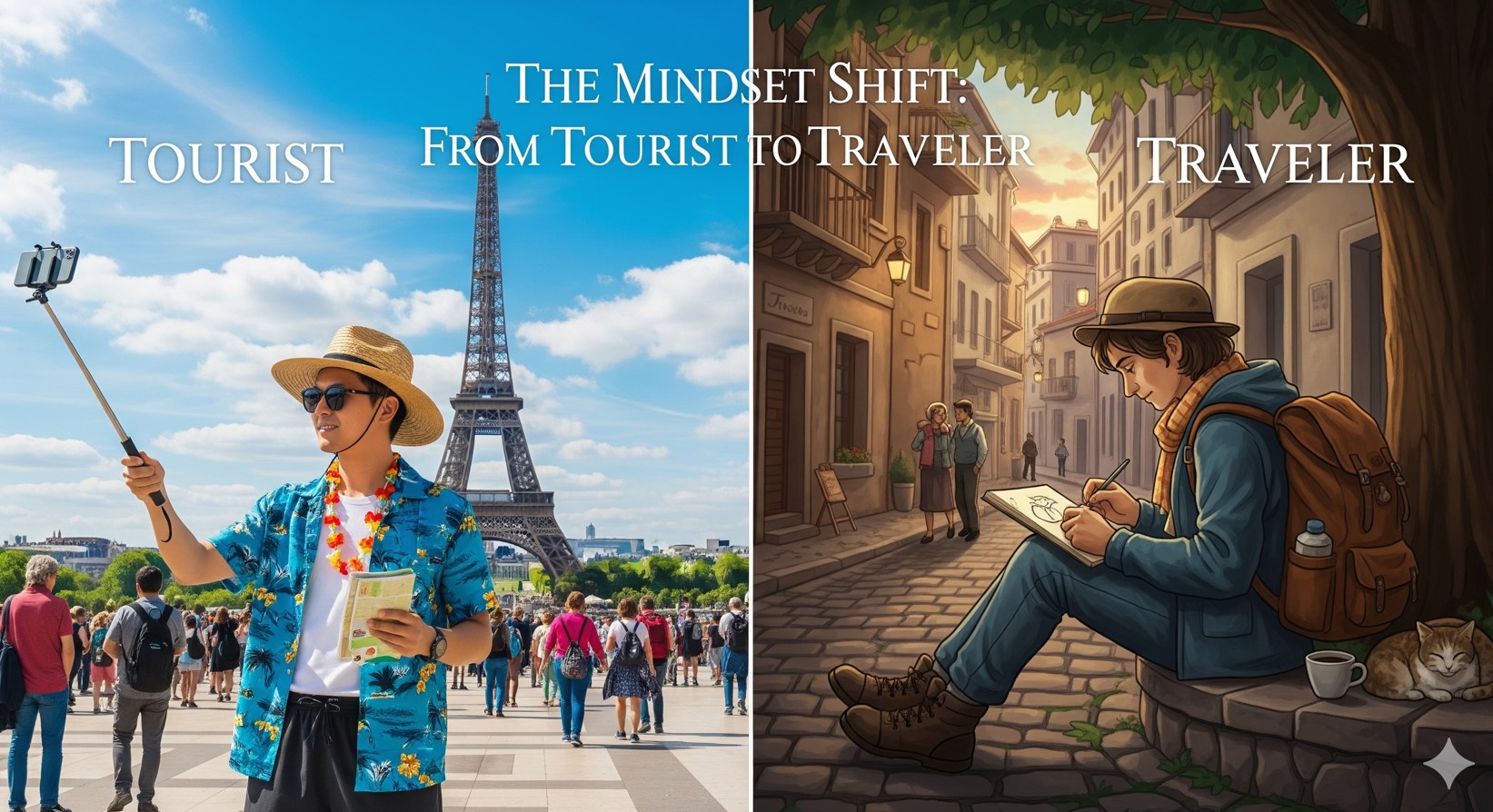The Traveler’s Dilemma: Seeing the Sights vs. Feeling the Place
Picture this: you’ve just landed in a new, exciting city. Your checklist is ready: the famous tower, the grand museum, the ancient ruins. You navigate through bustling crowds, snap the perfect photos for your social media feed, and buy a miniature replica of a landmark. At the end of the day, you return to your hotel room, exhausted but with a camera full of evidence that you were there. But were you, really? Did you feel the city’s pulse? Did you understand its rhythm? Or did you just skim its surface, following a well-trodden path paved for millions of visitors before you?
This is the common experience of a tourist. It’s a valid way to travel, but it often leaves a lingering feeling of disconnect, of having seen a place without truly experiencing it. There is another way. A deeper, more meaningful approach that transforms a simple vacation into a rich, immersive journey. This is the path of the traveler, not the tourist. It’s about seeking authentic experiences, stepping off the beaten path, and connecting with a destination on a human level. It’s about trading the postcard view for a genuine conversation, the souvenir shop for a bustling local market, and the guided bus tour for a spontaneous wander down a cobblestone alley.
This comprehensive guide is your roadmap to becoming a traveler. We’ll explore the mindset, the preparation, and the on-the-ground strategies you need to unlock authentic travel experiences and return home not just with photos, but with stories, connections, and a profound understanding of the places you visit.
The Mindset Shift: From Tourist to Traveler
Before you even book a flight, the most crucial step is to adjust your mindset. Authentic travel is less about where you go and more about how you go. It begins with an internal shift from a passive observer to an active and engaged participant.

Embrace Curiosity Over Checklists
A tourist arrives with a checklist; a traveler arrives with a question mark. While it’s fine to have a list of must-see sights, don’t let it become a prison. The real magic happens in the unplanned moments. Be genuinely curious. Why do locals gather in this specific park every evening? What is the story behind that unique architectural detail? What does that unfamiliar aroma from a street food stall taste like? Let your curiosity guide you. Follow a sound, a scent, or a street that looks interesting. This is how you discover the hidden gems that aren’t in any guidebook.
Practice Patience and Flexibility
The local way of life doesn’t operate on your schedule. Buses might be late, shops may close for an unexpectedly long lunch, and conversations may meander without a clear point. A tourist gets frustrated; a traveler sees it as part of the experience. Embrace the concept of “slow travel.” Instead of rushing from one sight to another, allow yourself to linger. Sit in a cafe for an hour and just watch the world go by. Accept that things may not go as planned, and view these detours not as setbacks, but as opportunities for spontaneous adventure.
Be a Gracious Guest, Not a Demanding Customer
Remember, you are a guest in someone else’s home. This simple reframing can change every interaction you have. Approach people with humility, respect, and a smile. You are not entitled to their time, their photo, or their help. Treat every person you meet—from the street vendor to the hotel clerk—with kindness. This simple act of being a gracious guest will open doors and hearts in ways you can’t imagine. It fosters positive interactions and ensures you leave a positive impact on the community you’re visiting.

Pre-Trip Preparation for Authentic Immersion
A truly immersive journey begins long before you pack your bags. Thoughtful preparation can lay the groundwork for a much richer and more respectful experience once you arrive.
Learn a Few Key Phrases
You don’t need to be fluent, but learning a handful of phrases in the local language is a powerful sign of respect. It shows you’ve made an effort. Focus on the essentials:
- Hello / Good morning / Good evening
- Please
- Thank you
- Excuse me / Sorry
- Yes / No
- Do you speak English? (Asking this in the local language is far more polite than simply assuming).
A simple “hello” in their own tongue can transform a transactional encounter into a warm human interaction.
Dive into Local History and Culture
Arriving with some context will dramatically deepen your appreciation for what you’re seeing. Read a novel by a local author, watch a film set in the country, or listen to its traditional music. Learn about the major historical events that shaped the nation’s identity. Understanding the cultural context will help you make sense of the social dynamics, the art, and the architecture you encounter. It turns a simple old building into a testament of a specific era and a local custom into a window into the nation’s soul.
Research Local Etiquette and Customs
What is considered polite in your home country might be rude elsewhere. Researching local customs is crucial to avoid unintentional offense. Key areas to look into include:
- Greeting Etiquette: Is it a handshake, a bow, or a kiss on the cheek?
- Dining Customs: Tipping culture, how to use utensils, whether it’s polite to finish your plate.
- Dress Codes: Especially when visiting religious sites, what is considered appropriate attire?
- Gestures: A simple hand gesture like a thumbs-up can have very different meanings around the world.
On the Ground: Your Guide to Living Like a Local
Once you’ve arrived, it’s time to put your traveler mindset into action. These strategies will help you break away from the tourist bubble and immerse yourself in the daily life of your destination.

Ditch the Hotel for Local Stays
While luxury hotels have their place, they often insulate you from the local culture. To get a real feel for a place, consider alternative accommodations. Renting an apartment in a residential neighborhood allows you to experience what it’s like to live there, shop at the corner store, and greet your neighbors. A homestay or a room in a family-run guesthouse offers an even deeper level of immersion, often including home-cooked meals and invaluable insider tips from your hosts.
Eat Where the Locals Eat
Food is the heart of any culture. Avoid the restaurants with multi-language menus and pictures of the food clustered around major tourist sights. The best food is often found where the locals go. How do you find these places? Look for establishments that are busy, especially with locals, during meal times. Wander a few blocks away from the main square. Don’t be afraid of street food stalls with long lines—a long line of locals is the best review you can get. Visit a local food market and ask a vendor what their favorite dish is and where to get it. Be adventurous and try the regional specialty, even if it sounds unfamiliar.
Master Public Transportation
Taxis and ride-sharing apps are convenient, but they shield you from the city. Taking the local bus, tram, or subway is a mini-adventure in itself. It’s a fantastic way to observe everyday life, see different neighborhoods, and get a better sense of the city’s layout. It forces you to navigate using local signs and interact, even non-verbally, with fellow passengers. Plus, it’s almost always more affordable and better for the environment.
Find the “Third Place”
Sociologists refer to the “third place” as the social environments separate from home (the first place) and work (the second place). These are the anchors of community life. Find the local third place. It might be a cozy neighborhood coffee shop where regulars chat with the barista, a public park where families gather in the late afternoon, or a local pub where friends meet after work. Spend some time there. Bring a book, but keep your eyes and ears open. This is where you’ll feel the true, unscripted rhythm of the community.
Connecting with People: The Heart of Authentic Travel
Ultimately, the most memorable travel experiences aren’t about places; they’re about people. Forging genuine human connections, however brief, is what transforms a trip into a cherished memory.
Strike Up Conversations
This can be intimidating, but it’s easier than you think. A simple, open-ended question is a great starting point. Instead of asking for directions (which can be answered with a point), ask for a recommendation. “I’m looking for the best coffee around here, what’s your favorite spot?” This invites an opinion and can open the door to a longer conversation. Compliment someone on their craft at a market. Ask a fellow passenger on the bus about their destination. Be genuine, be respectful, and be prepared for some conversations to go nowhere. But the ones that do will be worth their weight in gold.
Take a Local Class or Workshop
Participating in a shared activity is a fantastic way to meet locals with similar interests. Sign up for a cooking class to learn how to make a regional dish, take a pottery or craft workshop from a local artisan, or join a dance lesson. In this context, you�e2;�ac;�ac;�e2;�ac;�acre not a tourist; you’re a fellow student. It provides a natural, low-pressure environment for interaction and gives you a new skill to take home.
Hire a Local, Independent Guide
For a deeper dive into a specific aspect of the culture or history, consider hiring a local guide for a day or half-day. Bypass the large tour companies and look for independent guides or small, locally-owned operations. A passionate local guide can offer a personal perspective that you’d never get from a guidebook. They can tailor the experience to your interests, take you to their favorite spots, and facilitate introductions and conversations that you couldn’t manage on your own.
Technology: A Tool for Connection, Not a Barrier
Modern technology can be a double-edged sword for the authentic traveler. While it can trap you behind a screen, it can also be a powerful tool for deeper immersion if used wisely.
Use Maps for Discovery, Not Just Direction
Instead of just typing in a destination and blindly following the blue dot, use your map app to explore. Zoom into a neighborhood that looks interesting and switch to satellite or street view. Look for green spaces, public squares, or clusters of small, unnamed streets. Use it to get lost on purpose, knowing you have a safety net to find your way back.
Find Local Events and Meetups
Use apps and websites like Meetup, Eventbrite, or local Facebook groups to find out what’s happening during your stay. You might discover a free concert in a park, a neighborhood festival, a language exchange meetup, or a local sports game. Attending these events is a direct line into the local social scene.
The Journey Home: More Than Just a Souvenir
Traveling like a local is a conscious choice. It requires effort, vulnerability, and an open heart. It means trading comfort and predictability for authenticity and connection. When you choose this path, you bring home more than just souvenirs; you bring home a new perspective. You learn that despite our different languages and customs, we are all connected by a shared humanity.
The next time you plan a trip, challenge yourself to step off the tourist trail. Learn a few words, eat at a crowded local diner, take the bus, and smile at a stranger. You’ll find that the most profound and beautiful sights aren’t listed in any guidebook. They’re found in the shared laughter, the unexpected kindness, and the simple, quiet moments of genuine human connection. That is the true art of travel.








